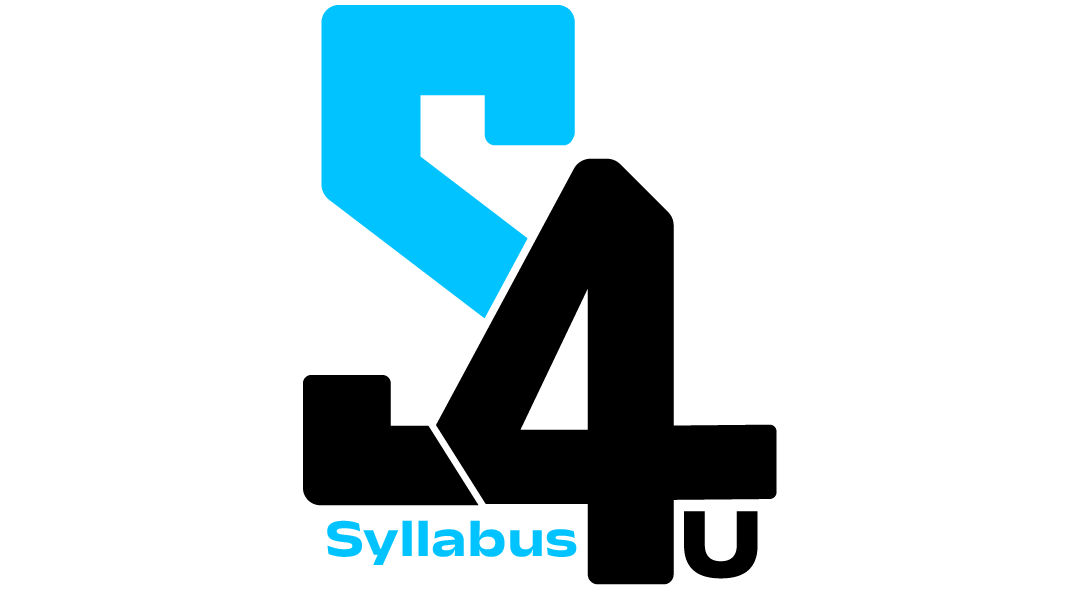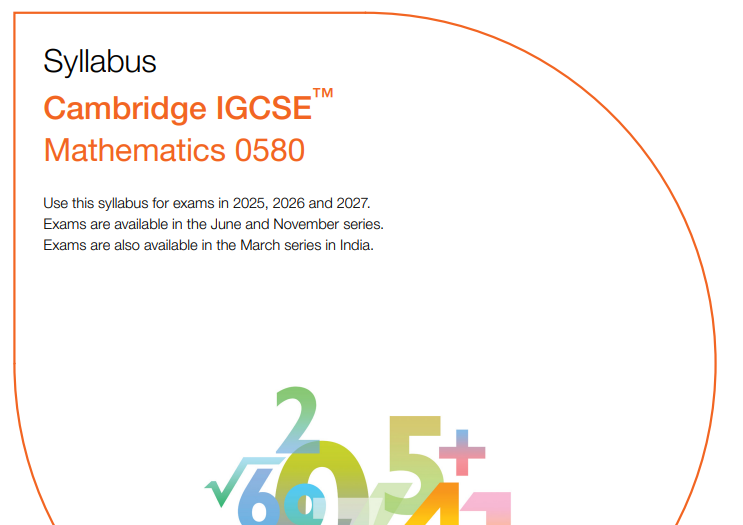The Cambridge IGCSE Mathematics (0580) syllabus for 2025 is designed to develop mathematical knowledge, logical reasoning, and problem-solving skills in students. It provides a solid foundation for further studies in mathematics and related disciplines. The syllabus is structured into two tiers: Core and Extended, allowing students to choose the level that best suits their abilities and future academic goals.
The Core curriculum covers fundamental topics such as numbers, algebra, geometry, mensuration, statistics, and probability, ensuring students grasp essential mathematical concepts. The Extended curriculum builds on these topics with more depth and complexity, preparing students for advanced studies.
The assessment consists of four papers: Paper 1 and Paper 3 for Core candidates, and Paper 2 and Paper 4 for Extended candidates. These papers evaluate students’ proficiency in problem-solving, analytical thinking, and applying mathematical concepts to real-world situations.
The 0580 syllabus 2025 aligns with international standards, promoting critical thinking and practical application. It encourages students to develop confidence in using mathematics for everyday and academic purposes. Mastering the syllabus will equip students with essential skills for careers in science, engineering, finance, and technology.
With a well-structured approach, the Cambridge IGCSE 0580 syllabus ensures a comprehensive and engaging learning experience for students worldwide.
The 0580 syllabus refers to the Cambridge IGCSE Mathematics (0580) syllabus for 2025. Below is a detailed outline of the syllabus:
Cambridge IGCSE Mathematics 0580 Syllabus 2025
Overview
The syllabus is designed for students preparing for the Core or Extended curriculum. The Core curriculum covers fundamental concepts, while the Extended curriculum includes more complex topics for students aiming for higher grades.
Number
- Integers, fractions, decimals, and percentages
- Ordering numbers and standard form
- Indices and surds (Extended only)
- Ratio, proportion, and direct/inverse variation
- Estimation and bounds
Algebra
- Algebraic expressions, expansion, and factorization
- Linear and quadratic equations
- Simultaneous equations (linear & quadratic in Extended)
- Sequences (arithmetic, geometric)
- Functions, graphs, and inequalities
- Algebraic fractions and their simplification (Extended)
Geometry
- Properties of angles, lines, and shapes
- Symmetry (line and rotational)
- Congruence and similarity
- Pythagoras’ theorem and trigonometry (sine, cosine, tangent)
- Circles (chords, tangents, and angles)
- Vectors and transformations
Mensuration
- Area and perimeter of shapes
- Surface area and volume of 3D solids (cylinders, cones, spheres in Extended)
- Arc length and sector area (Extended)
Co-ordinate Geometry
- Graphs of linear and quadratic functions
- Distance between two points
- Midpoint and gradient of a line
- Equation of a straight line
Trigonometry
- Sine, cosine, and tangent ratios
- Trigonometric calculations in right-angled triangles
- Sine and cosine rules (Extended)
- Area of a triangle using trigonometry (Extended)
- Graphs of sine, cosine, and tangent functions
Statistics and Probability
- Mean, median, mode, and range
- Frequency tables and histograms
- Probability rules and tree diagrams (Extended)
- Cumulative frequency and box plots (Extended)
- Standard deviation (Extended)
Matrices and Transformations (Extended only)
- Matrix operations and inverses
- Transformations (reflection, rotation, translation, enlargement)
Functions and Calculus (Extended only)
- Function notation and inverse functions
- Differentiation (basic calculus)
- Gradients and stationary points
- Applications of differentiation (tangents, normals)
0580 Examination Structure
Students can take either Core or Extended papers:
✅ Core (Grades C-G)
- Paper 1: Multiple-choice (35%)
- Paper 3: Structured questions (65%)
✅ Extended (Grades A-E)*
- Paper 2: Multiple-choice (35%)
- Paper 4: Structured questions (65%)
- Number
- Algebra and Graphs
- Coordinate Geometry
- Geometry
- Mensuration
- Trigonometry
- Transformations and Vectors
- Probability
- Statistics
1. Number
Core Topics:
- Understanding and using various types of numbers, including natural numbers, integers, fractions, decimals, and percentages.
- Performing calculations involving the four basic operations and applying the correct order of operations.
- Rounding numbers to a specified number of decimal places or significant figures.
- Understanding and applying concepts of ratio, proportion, and rate.
- Calculating with money and converting between different currencies.
Extended Topics:
- Working with surds, including simplifying expressions and rationalizing denominators.
- Applying concepts of upper and lower bounds in calculations.
- Solving problems involving compound interest and exponential growth and decay.
2. Algebra and Graphs
Core Topics:
- Using letters to represent generalized numbers and substituting numbers into expressions and formulas.
- Simplifying expressions by collecting like terms and expanding products of algebraic expressions.
- Solving linear equations in one unknown and constructing simple equations and formulas.
- Representing inequalities on a number line.
- Continuing and finding patterns in sequences.
- Constructing tables of values and drawing graphs for functions like y=mx+cy = mx + c.
Extended Topics:
- Solving simultaneous linear equations in two unknowns.
- Changing the subject of complex formulas.
- Solving quadratic equations by factorization, completing the square, and using the quadratic formula.
- Understanding and using indices, including negative and fractional indices.
- Working with functions, including understanding domain and range, and using function notation.
3. Coordinate Geometry
Core Topics:
- Using and interpreting Cartesian coordinates in two dimensions.
- Drawing straight-line graphs for linear equations.
- Determining the equation of a straight line in the form y=mx+cy = mx + c.
Extended Topics:
- Finding the gradient of a straight line from its equation.
- Calculating the length and midpoint of a line segment.
- Finding the equation of a straight line parallel or perpendicular to a given line.
4. Geometry
Core Topics:
- Using and interpreting geometrical terms and facts, including properties of angles, triangles, quadrilaterals, and polygons.
- Calculating unknown angles using properties of angles at a point, on a straight line, and intersecting lines.
- Understanding and using the properties of parallel lines, circles, and polygons.
- Recognizing and describing transformations such as reflections, rotations, translations, and enlargements.
Extended Topics:
- Applying circle theorems to calculate unknown angles.
- Understanding and using the properties of similar and congruent shapes.
- Recognizing and describing combinations of transformations.
5. Mensuration
Core Topics:
- Calculating perimeters and areas of various shapes, including rectangles, triangles, and circles.
- Calculating volumes and surface areas of solids like cuboids, cylinders, and spheres.
Extended Topics:
- Solving problems involving arc length and sector area of a circle.
- Calculating surface areas and volumes of more complex solids, including pyramids, cones, and composite shapes.
6. Trigonometry
Core Topics:
- Applying Pythagoras’ theorem.
- Using sine, cosine, and tangent ratios to calculate sides and angles in right-angled triangles.
Extended Topics:
- Using the sine and cosine rules in non-right-angled triangles.
- Calculating the area of a triangle using 12absinC\frac{1}{2}ab\sin C.
- Solving simple trigonometric equations within a specified range.
7. Transformations and Vectors
Core Topics:
- Recognizing and describing transformations such as reflections, rotations, translations, and enlargements.
- Describing a translation using a vector.
Extended Topics:
- Combining transformations.
- Using matrix representations of transformations.
- Performing calculations with vectors, including addition, subtraction, and multiplication by scalars.
8. Probability
Core Topics:
- Understanding and using the probability scale from 0 to 1.
- Calculating the probability of a single event.
- Understanding that the probability of an event not occurring is 1 minus the probability of it occurring.
Extended Topics:
- Calculating the probability of combined events using the addition and multiplication rules.
- Using tree diagrams to represent and calculate probabilities.
Cambridge IGCSE Mathematics PDF
Download Cambridge IGCSE Maths PDF vy clicking on the below link.
FAQs
The Cambridge IGCSE Mathematics (0580) syllabus has undergone several updates for the 2025–2027 examination series. Below are some frequently asked questions (FAQs) regarding these changes:
1. What are the significant changes in the 0580 syllabus for 2025–2027?
The syllabus has been updated to improve clarity and assessment methods. Notable changes include the introduction of a non-calculator paper at each tier, rebalancing of examination papers for better accessibility, and updates to subject content with some topics added and others removed.
2. Which topics have been added or removed in the updated syllabus?
In the Extended curriculum, topics such as surds, domain and range, and exact trigonometric values have been added. Conversely, topics like linear programming, box-and-whisker plots, and congruence criteria have been removed.
3. How has the assessment structure changed?
A non-calculator assessment has been introduced at each tier to enhance candidates’ mathematical problem-solving skills without reliance on a calculator. Additionally, the examination papers have been rebalanced to provide improved accessibility and a better candidate experience.
4. Will there be a formula sheet provided during the exam?
For assessments held from 2025 onwards, a formula sheet is provided on page 2 of the Mathematics examinations. Students are expected to memorize all other formulas that are not on the sheet, such as the volume of a cube.
5. Are there any changes to the use of calculators in the exam?
Yes, with the introduction of a non-calculator paper, students will need to enhance their mental math skills and learn shortcuts to perform calculations efficiently without a calculator.
Related Article: 9709 Syllabus


1 thought on “0580 Syllabus 2025, Check Cambridge IGCS Mathematics PDF”